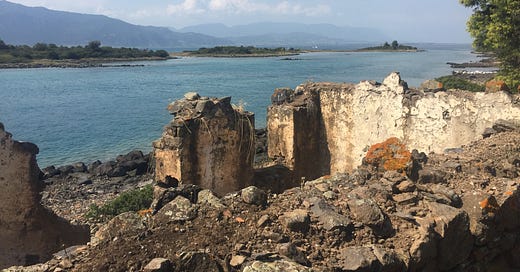Where does the island name ‘Leslo’ come from?
While the name appears in Paul McCartney’s authorised biography, the author’s records suggest it didn’t originate from the Beatle himself.
One persistently puzzling aspect of the Beatles’ dream of buying a Greek island is the name ‘Leslo’.
This is the label often attributed to the island the group wanted to buy in 1967 – and its appearance in books by respected Beatles authors lends weight to this supposed fact. However, there appears to be no actual Greek island that the name belongs to.
One of the most influential books that refers to ‘Leslo’ is Many Years from Now (1997), Barry Miles’ authorised biography of Paul McCartney. When I was in Liverpool last summer for a Beatles symposium, I had the chance to visit the archive at Liverpool John Moores University (LJMU) which holds the material Miles used to write this book – including his interview transcripts and early drafts.
You never know how useful an archive will be until you go, and many files that seem potentially promising yield nothing. But pleasingly, this visit did actually shed some light on the origins of ‘Leslo’: it appears that Miles added the name into his text at a late stage.
The archive holds a number of draft manuscripts of Miles’ book. All of these include the Greek island episode, but not all of them call the island ‘Leslo’. In two early versions, the island is simply described as "a large island of about 80 acres". But this changed by the time Miles submitted the manuscript to his editor. In this draft, the text uses the same description that appears in the published book: "the island of Leslo, of about 80 acres".
Here's the passage from Many Years From Now, where Miles describes the visit made by Alexis Mardas and Alistair Taylor to Greece to “look at real estate”.
After several false starts, they found the perfect place: the island of Leslo, of about 80 acres, with four idyllic beaches and four smaller habitable islands surrounding it – one for each Beatle. The entire property was for sale for £90,000, including a small fishing village of traditional white-painted houses grouped around a harbour filled with brightly coloured fishing boats and 16 acres of olive groves.
The LJMU archive also holds Miles’ interview transcripts, which record that Paul discussed the plans to buy a Greek island with the author in November 1992. But this conversation doesn’t include any of the specific details about the island that Miles gives in the quote above. So, where do these come from?
It seems likely that Miles’ source for most of these is Alistair Taylor's memoir Yesterday (1988), which matches almost all of the details – from the £90,000 price tag to the 16 acres of olive groves. But crucially, Taylor doesn’t name the island.
I think it’s very possible that the name 'Leslo' comes from another book: Bill Harry's Ultimate Beatles Encyclopedia, published in 1992. (Like Yesterday, this is cited in the Many Years From Now bibliography.) Under the heading ‘Leslo’, Harry’s encyclopaedia says: “Name of the island which the Beatles purchased in 1967, intending it to be an idyllic retreat where they would create their own community.”
So, while ‘Leslo’ does appear in Paul McCartney’s authorised biography, it’s unlikely that this information came from the Beatle himself. It’s unlikely, too, that it was actually the name of the place the Beatles wanted in Greece (which in my view, was most likely the Lichadonisia islands). But if Miles did get the name from Bill Harry’s book, the mystery of ‘Leslo’ still isn’t solved completely: we still don’t know where Harry got it from. The other information in the encyclopaedia entry suggests that Peter Brown’s The Love You Make (1983) was a major source – but this book doesn’t give a name for the island. Perhaps ultimately the name derives from the bizarre ‘Be at Leso’ mythology which arose from the Sgt. Pepper album cover.
In any case, this issue does not detract from the strengths of Barry Miles’ book overall. The wealth of material in his archive made clear to me how in-depth and well-sourced Miles’ research was. The name of the island is a minor aspect of his book. However, the puzzle that it presents reminds us of how even in work by the most diligent authors, inaccuracies can creep in. That’s just the nature of researching and writing history.
We’re also reminded that writers often use information from other books. Again, this is a normal and expected part of the process. But it does have the potential to distort historical accounts. And one wonders what other inaccuracies it may have led to elsewhere within Beatles histories – especially where (as sometimes happens) material is recycled uncritically and without attribution.
For me, the ‘Leslo’ confusion also underlines the futility of believing that there will ever be a ‘definitive’ version of all the facts about the group – let alone how we interpret these. There’s always more to say about their story.
Read more:
Where is ‘Leslo’, the Greek island the Beatles wanted to buy?
John Lennon’s island fantasies
Actor, architect, soldier… spy? The intriguing inner circle of Alexis Mardas




excellent as always.
My one comment -- "That’s just the nature of researching and writing history."
That's true, but when it comes to this story, the distortions and careless research and bending of the truth to fit an agenda, and the willful omission of credible sources because they don't support the narrative that the writer wants to tell are especially egregious, to the point where a good portion of what's in those books (including Miles') is fiction.
That's a big problem, given the importance of this story to shaping our culture and our history. It's a large part of why I'm publishing the series.